Cleaning your Bunn coffee maker is essential for maintaining its performance and longevity. Regular maintenance ensures optimal brewing and prevents mineral buildup. Use denture cleaning tablets or vinegar for effective cleaning. Focus on the water tank and brew head for the best results.
1.1 Why Regular Cleaning is Essential
Regular cleaning is crucial for maintaining your Bunn coffee maker’s performance and longevity. Mineral buildup from water can clog internal components, while old coffee oils and residue can impart bitter flavors to your brew. Over time, bacteria and mold may grow, affecting the taste and hygiene of your coffee. Cleaning ensures consistent flavor quality, prevents clogs, and maintains the machine’s efficiency. Use vinegar or descaling solutions regularly to remove mineral deposits and keep your coffee maker in optimal condition. A clean machine brews better coffee and lasts longer.
- Prevents mineral buildup and clogs
- Removes old coffee oils and residue
- Maintains hygiene and fresh flavor
1.2 Overview of Bunn Coffee Maker Components
Bunn coffee makers consist of key components that require regular cleaning, including the water tank, brew head, carafe, and portafilter. The water tank holds fresh water for brewing, while the brew head distributes water over coffee grounds. The carafe collects the brewed coffee, and the portafilter holds the coffee grounds. Understanding these parts helps target cleaning efforts effectively, ensuring optimal performance and flavor.
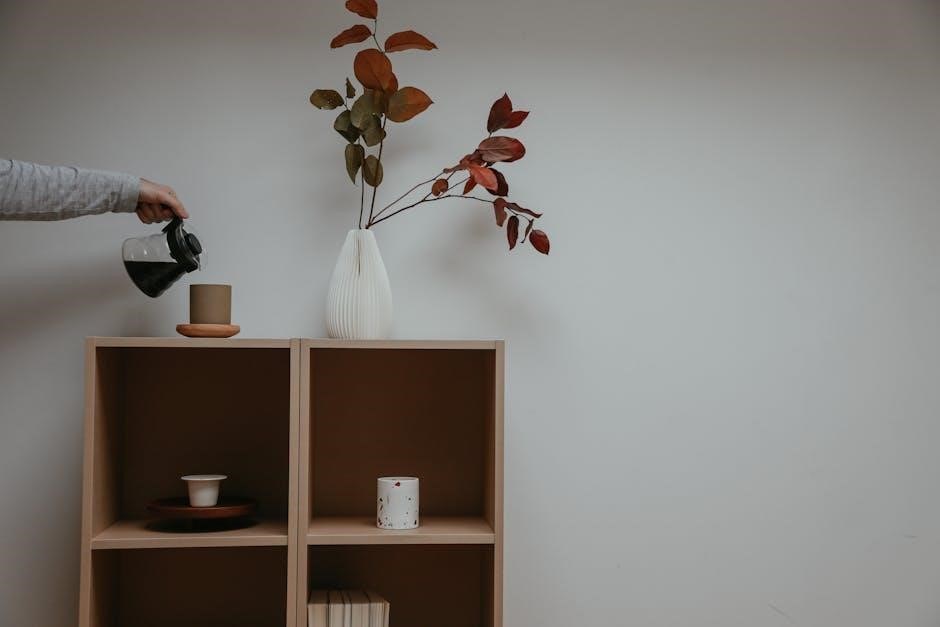
Understanding the Importance of Cleaning
Cleaning your Bunn coffee maker prevents mineral buildup, removes old coffee oils, and ensures hygiene. Regular maintenance enhances flavor, prevents clogs, and extends the machine’s lifespan. Consistency is key.
2.1 Preventing Mineral Buildup
Mineral buildup, or scaling, is a common issue in Bunn coffee makers, especially in areas with hard water. Over time, minerals like calcium and lime accumulate inside the machine, slowing down water flow and reducing efficiency. Regular descaling is crucial to prevent this buildup. Use a descaling solution or vinegar to remove mineral deposits. This process helps maintain optimal water flow and ensures your coffee tastes fresh. Clean the water tank and brew head regularly to prevent scaling and extend the lifespan of your coffee maker.
2.2 Removing Old Coffee Oils and Residue
Old coffee oils and residue can buildup inside your Bunn coffee maker, leading to bitter flavors and reduced performance. To address this, mix equal parts water and white vinegar or use a baking soda paste to soak removable parts. Scrub the brew head and carafe thoroughly, then rinse with fresh water. For tougher residue, soak components overnight. Regularly cleaning these areas ensures your coffee tastes fresh and prevents clogging. This step is crucial for maintaining the machine’s efficiency and your coffee’s quality.
2.3 Maintaining Hygiene and Freshness
Regular cleaning of your Bunn coffee maker is crucial for maintaining hygiene and ensuring freshly brewed coffee. Over time, residue and bacteria can accumulate, affecting the taste and quality of your coffee. By incorporating methods like vinegar cleaning or using denture cleaning tablets, you can effectively remove contaminants and odors, keeping your machine sanitized and your coffee fresh.
Consistent hygiene practices prevent mold growth and bacterial buildup, ensuring a clean and safe brewing environment. This routine also helps preserve the machine’s efficiency and your coffee’s flavor profile.
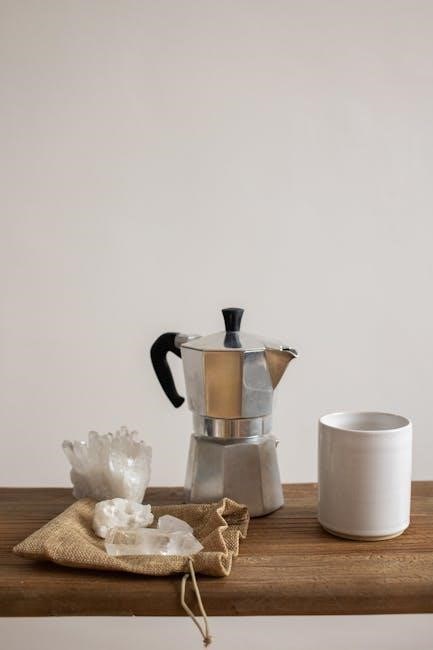
Preparing for Cleaning
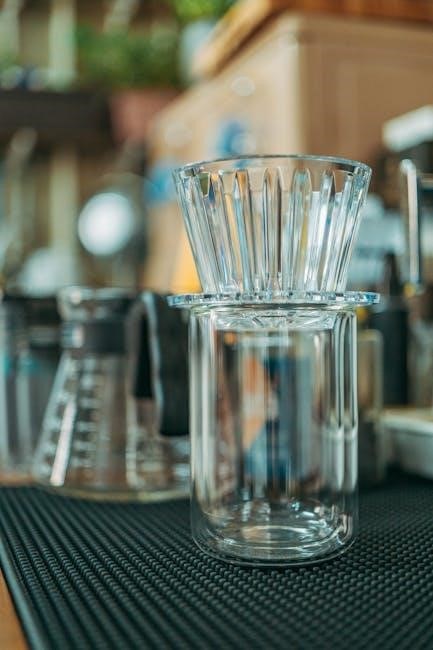
Gather supplies like baking soda, water, white vinegar, and a soft cloth. Turn off and unplug the coffee maker for safety. Ensure all parts are cool before cleaning;
3.1 Gathering Necessary Supplies
To clean your Bunn coffee maker effectively, gather essential supplies. These include white vinegar, a soft sponge, microfiber cloth, filtered water, and a descaling solution if needed. For tougher stains, consider denture cleaning tablets or a baking soda paste. Always have gloves and a clean container handy for soaking parts. Ensure all materials are non-abrasive to avoid damaging the machine’s surfaces. Having these supplies ready will make the cleaning process efficient and thorough.
3.2 Turning Off and Unplugging the Coffee Maker
Before cleaning, ensure your Bunn coffee maker is turned off and unplugged from the power source. This step is crucial for safety, preventing electrical hazards or accidental activation. Allow the machine to cool down completely to avoid burns during handling. Disconnecting the power also ensures no electrical components are damaged during the cleaning process. Always prioritize this step to maintain safety and prepare the coffee maker for effective maintenance.
- Unplug the coffee maker to prevent electrical issues.
- Let it cool to avoid burns during cleaning.
- Ensure all lights or indicators are off.
3.4 Ensuring Safety Precautions
Before cleaning, ensure your Bunn coffee maker is turned off and unplugged to avoid electrical hazards. Allow it to cool down completely to prevent burns. Wear protective gloves when handling cleaning solutions. Always rins thoroughly after using any cleaning agents to remove residues. These precautions ensure a safe and effective cleaning process.
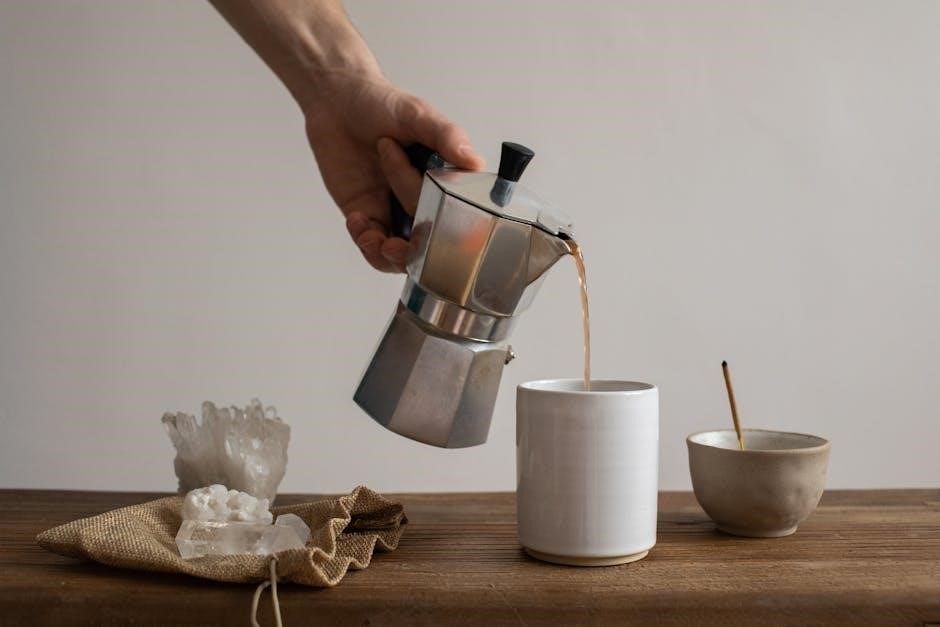
Daily Cleaning Routine
Wipe down the exterior with a damp cloth and empty the brew basket after each use. Rinse the carafe and coffee pot thoroughly with fresh water daily.
4.1 Wipe Down Exterior Surfaces
Start by wiping the exterior of your Bunn coffee maker with a clean, damp cloth to remove dust, fingerprints, and splatters. Use a mild detergent if needed, but avoid abrasive cleaners or scrubbers that could damage the finish. Pay attention to buttons, knobs, and areas around the brew head, as these tend to accumulate residue. Regular wiping prevents buildup and keeps the machine looking new. For tougher stains, mix equal parts water and white vinegar on a soft cloth and gently scrub the area before rinsing with a clean, damp cloth.
4.2 Empty and Clean the Brew Basket
After each use, remove and empty the brew basket to prevent old grounds from affecting the taste of future brews. Rinse it under warm water to eliminate any residue. For tougher stains, soak the basket in a mixture of warm water and vinegar for about 30 minutes. Scrub gently with a soft sponge, then rinse thoroughly. Regular cleaning prevents oil buildup and ensures a fresh coffee flavor. Always dry the basket before reassembling your Bunn coffee maker.
4.3 Rinse the Carafe and Coffee Pot
Rinsing the carafe and coffee pot is a crucial step in daily maintenance. After each use, rinse them thoroughly with fresh water to remove any leftover coffee residue. For deeper cleaning, mix mild dish soap with warm water, soak for 10-15 minutes, then scrub and rinse. Avoid using abrasive materials that could scratch surfaces. Regular rinsing prevents stains and odors, ensuring a fresh taste in every brew. For natural cleaning, soak with vinegar solution or use denture cleaning tablets for a sparkling finish. Always dry thoroughly to prevent water spots.
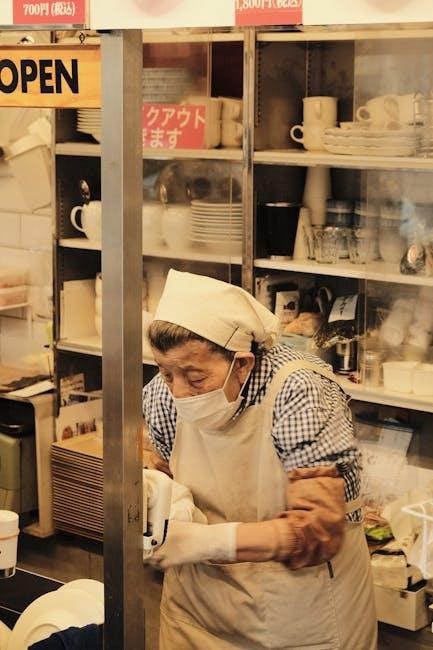
Descaling Your Bunn Coffee Maker
Descaling your Bunn coffee maker is crucial for maintaining its efficiency and preventing mineral buildup. Use a descaling solution or vinegar to remove scale. Run the solution through the machine as per instructions, then rinse thoroughly with water to eliminate any residual taste.
5.1 Understanding the Descaling Process
Descaling is crucial for removing mineral deposits that build up inside your Bunn coffee maker, especially in areas with hard water. Over time, calcium and lime accumulate, slowing water flow and affecting taste. Use a descaling solution or white vinegar to dissolve these deposits. The process involves running the solution through the machine’s water cycle, then rinsing thoroughly to remove any residue. Descaling should be done every 1-3 months, depending on usage and water hardness, to maintain optimal performance and prevent damage.
5.2 Using a Descaling Solution
Descaling is crucial for removing mineral deposits that affect flavor and performance. Mix the descaling solution with water as directed. Pour the mixture into the water reservoir and run a brew cycle. Repeat until the solution is fully drained. Rinse thoroughly by running several cycles with fresh water to remove any residues. For eco-friendly options, vinegar or denture cleaning tablets can be effective alternatives. Always follow the manufacturer’s guidelines for optimal results and to ensure longevity.
5.3 Rinsing After Descaling
Rinsing your Bunn coffee maker after descaling is crucial to remove any lingering descaling solution. Run 2-3 cycles of fresh water through the machine to ensure no residue remains. Check the water for any unusual taste or odor after rinsing. If present, repeat the process until the water runs clean. Finally, wipe down the exterior to prevent mineral spots from forming. This step ensures your coffee maker is ready for brewing fresh, clean coffee.
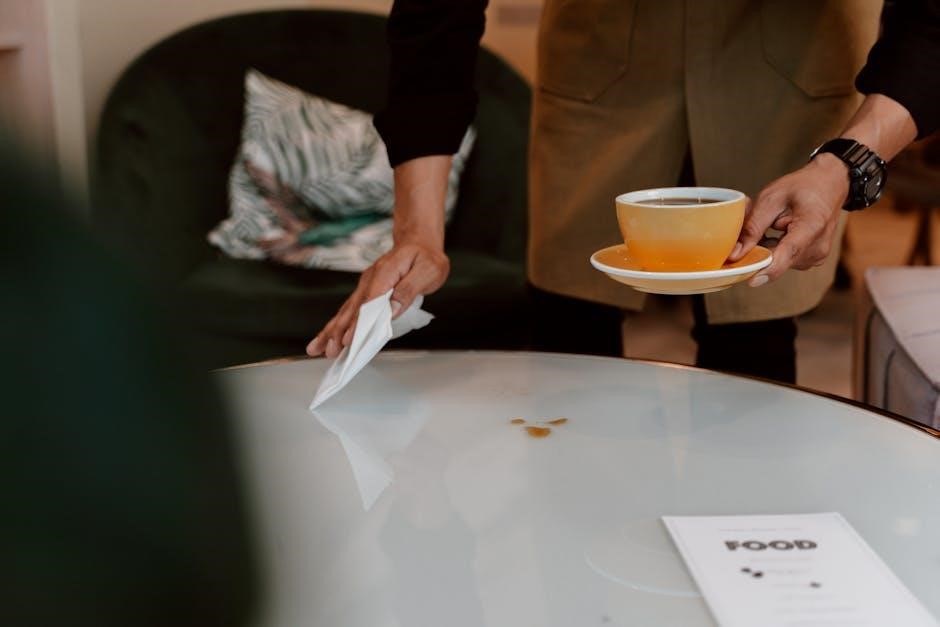
Deep Cleaning the Coffee Maker
Deep cleaning involves soaking removable parts in warm soapy water and scrubbing internal components. Regular deep cleaning prevents buildup and ensures consistent coffee quality over time.
6.1 Soaking Removable Parts
Soaking removable parts like the brew head and basket helps remove stubborn coffee oils and residue. Fill a bowl with warm water and add a cleaning solution or denture cleaning tablets. Submerge the parts for about an hour to loosen grime. After soaking, scrub gently with a soft brush and rinse thoroughly; This step ensures a deeper clean and prevents clogs. Always dry the parts before reassembling to maintain hygiene and prevent water spots.
6.2 Cleaning the Water Tank
Cleaning the water tank of your Bunn coffee maker is crucial to prevent mineral buildup and bacteria growth. Regularly rinse the tank with fresh water after use. For deep cleaning, mix a solution of white vinegar and water, soak the tank, and scrub gently. Alternatively, denture cleaning tablets can be used for a natural cleaning process. Always rinse thoroughly after cleaning to ensure no residue remains, ensuring fresh-tasting coffee every time.
6.3 Sanitizing the Internal Components
Sanitizing internal components ensures your Bunn coffee maker remains free from bacteria and mold. Mix a solution of equal parts water and white vinegar or use a descaling solution. Pour the mixture into the water tank and run a brewing cycle without coffee grounds. Repeat if necessary. For tougher buildup, soak removable parts in hot soapy water. Always rinse thoroughly to remove any cleaning solution residue. Regular sanitizing every 1-2 months keeps your coffee tasting fresh and prevents contamination.

Common Issues and Solutions
Address clogged water flow by descaling regularly. For stains, soak parts in warm water. Eliminate odors with vinegar rinses to keep your Bunn coffee maker fresh.
7.1 Clogged Water Flow
Clogged water flow in Bunn coffee makers is often caused by mineral buildup or debris. To resolve this, soak the water tank and brew head in a mixture of water and white vinegar or a descaling solution. Run a few cycles without coffee grounds to flush out the system. For severe blockages, use a denture cleaning tablet dissolved in warm water to break down tough residue. Regular descaling and cleaning prevent future clogs and ensure smooth operation.
7.2 Stains and Discoloration
Stains and discoloration on your Bunn coffee maker can occur due to coffee oil residue, mineral deposits, or spills. To address these, mix equal parts water and white vinegar in the carafe. Pour the solution into the reservoir and brew as usual. For stubborn stains, let the solution sit for 30 minutes before rinsing thoroughly. For tougher discoloration, soak removable parts in a mixture of baking soda and warm water. Avoid using harsh chemicals, as they may damage the machine. Regular cleaning helps prevent these issues and keeps your coffee maker looking new.
7.3 Odor Removal
Odors in Bunn coffee makers often stem from old coffee oils and mineral buildup. To eliminate smells, mix equal parts water and white vinegar in the water tank and run a brewing cycle. Repeat if the odor persists. For stubborn odors, soak removable parts in a solution of warm water and denture cleaning tablets. Always rinse thoroughly after cleaning to remove any lingering tastes or odors. Regular descaling and cleaning can prevent odors from forming in the first place.
Optional Deep Cleaning Methods
For deeper cleaning, try using vinegar solutions or baking soda paste. These methods effectively remove stubborn stains and odors without harsh chemicals, ensuring a fresh brewing experience.
8.1 Using Vinegar for Natural Cleaning
Vinegar is a natural and effective cleaning agent for Bunn coffee makers. Mix equal parts white vinegar and water, then run the solution through the machine. Repeat the cycle to ensure thorough cleaning. Afterward, rinse with fresh water to remove any vinegar taste. This method helps remove mineral deposits and coffee residue, keeping your machine in great condition. Regular vinegar cleaning prevents buildup and maintains optimal performance without harsh chemicals. It’s a simple, eco-friendly way to keep your coffee maker fresh and functioning well.
8.2 Baking Soda and Water Paste
A baking soda and water paste is a natural cleaning solution for Bunn coffee makers. Mix 1 tablespoon of baking soda with 2 tablespoons of warm water to form a smooth paste. Apply it to stained or mineral-heavy areas, such as the brew head or water tank. Let it sit for 30 minutes to break down residue. Scrub gently with a soft brush, then rinse thoroughly with fresh water. This method is effective for removing tough stains and odors without harsh chemicals.
8.3 Denture Cleaning Tablets
Denture cleaning tablets can be an effective and unconventional method for deep cleaning your Bunn coffee maker. Simply drop one tablet into the water tank, allow it to dissolve, and run a brew cycle. The mild abrasives in the tablets help break down stubborn stains and mineral deposits without damaging the machine. After cleaning, rinse thoroughly with fresh water to remove any residue. This method is quick, easy, and ideal for removing tough buildup while maintaining your coffee maker’s performance and hygiene.
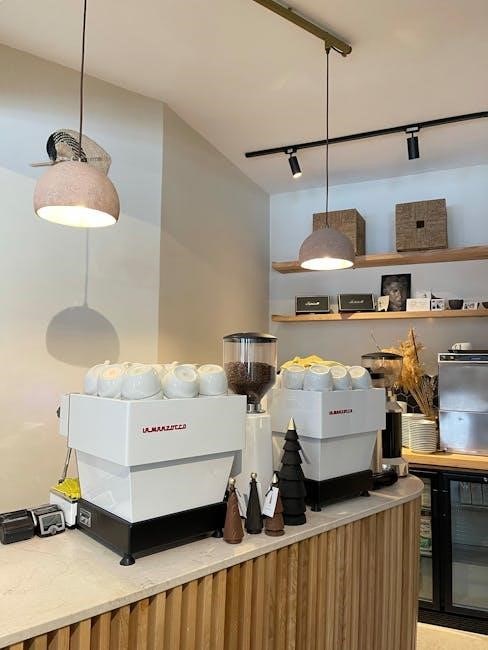
Tips for Better Coffee Performance
For optimal brewing, use filtered water and maintain a regular cleaning schedule. Ensure the water reaches the ideal temperature for extraction. Experiment with coffee-to-water ratios to enhance flavor consistency and aroma.
9.1 Regular Maintenance Schedule
A consistent cleaning routine is crucial for your Bunn coffee maker. Clean the brew basket and carafe daily after use. Perform descaling every 1-3 months to prevent mineral buildup. Deep clean the water tank monthly by soaking it in warm soapy water. Wipe down the exterior weekly to remove dust and splatters. Stick to this schedule to ensure optimal performance and extend the lifespan of your coffee maker.
9.2 Using Filtered Water
Using filtered water is crucial for optimal coffee taste and machine efficiency. It reduces mineral content, preventing scaling and extending the lifespan of your Bunn coffee maker. Filtered water also minimizes the risk of clogged water flow and ensures a cleaner brewing process. Regularly replace your water filter to maintain freshness and prevent impurities from affecting your coffee’s flavor. This simple step enhances both the quality of your brew and the longevity of your coffee maker.
9.3 Storing the Coffee Maker Properly
Proper storage of your Bunn coffee maker is crucial for maintaining its performance and longevity. Always clean and descale the machine before storing it, especially if you won’t be using it for an extended period. Dry all components thoroughly to prevent moisture buildup and mold. Store the coffee maker in a cool, dry place, away from direct sunlight and humidity. For added protection, cover it with a cloth to keep dust away. Ensure the power cord is neatly wound to avoid damage. If storing for a long time, consider disassembling parts like the carafe and brew basket, and keep them in a well-ventilated area to maintain freshness. Proper storage practices will help preserve the quality and extend the lifespan of your Bunn coffee maker.
Consistently cleaning your Bunn coffee maker ensures longevity and optimal performance. Regular descaling, rinsing, and natural methods like vinegar keep it functioning at its best.
10.1 Summary of Cleaning Steps
To maintain your Bunn coffee maker, follow a consistent cleaning routine. Daily, wipe down surfaces and empty the brew basket. Weekly, descale to remove mineral buildup and deep clean removable parts. Use vinegar or a descaling solution for optimal results. Soak components in warm water and sanitize internal parts regularly. For tough stains, a baking soda paste can be effective. Always rinse thoroughly after cleaning to ensure freshness. Consistency in these steps will keep your coffee maker functioning at its best and prolong its lifespan.
10.2 Importance of Consistent Maintenance
Consistent maintenance is crucial for preserving your Bunn coffee maker’s performance and longevity. Regular cleaning prevents mineral buildup and bacteria growth, ensuring a fresh taste in every brew. Over time, neglecting maintenance can lead to clogged parts and reduced efficiency. By following a routine, you protect your investment and enjoy a better coffee experience. Keep your Bunn coffee maker in top shape with dedication to its care.
10.3 Final Tips for Longevity
To ensure your Bunn coffee maker lasts, avoid harsh chemicals and opt for natural cleaners like vinegar. After cleaning, dry all parts thoroughly to prevent mold. Regularly check for worn-out seals or hoses and replace them promptly. Store the machine in a dry place when not in use. Using filtered water can also help reduce mineral buildup over time, ensuring optimal performance and extending the lifespan of your coffee maker.
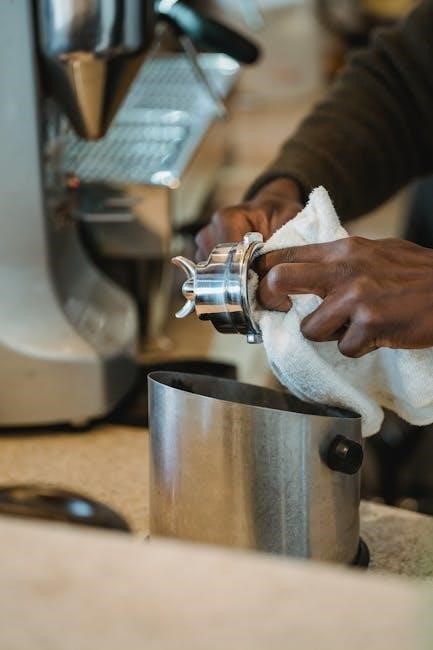
Frequently Asked Questions
- How often should I clean my Bunn coffee maker? Clean it daily and descale every 3-6 months for optimal performance.
- Can I use dish soap? Avoid harsh chemicals; use mild cleaners or vinegar for safer cleaning.
- What if I don’t descale regularly? Mineral buildup can damage the machine and affect taste.
11.1 How Often Should I Clean My Bunn Coffee Maker?
Regular cleaning is crucial for maintaining your Bunn coffee maker’s performance. Clean the brew basket and carafe daily after use. Wipe down the exterior and empty any residual water. Descaling should be done every 1-3 months, depending on water hardness. Deep cleaning with vinegar or a descaling solution is recommended monthly. Consistent maintenance ensures optimal brewing and prevents mineral buildup, keeping your coffee fresh and flavorful. Neglecting cleaning can lead to poor taste and machine malfunction over time.
11.2 Can I Use Dish Soap for Cleaning?
While dish soap can clean surfaces, it’s not recommended for Bunn coffee makers. Soap residue can affect the taste of coffee and damage internal components. Instead, use vinegar or a descaling solution for safe and effective cleaning. Always rinse thoroughly after cleaning to ensure no residual flavors remain.
11.3 What If I Don’t Descale Regularly?
If you don’t descale your Bunn coffee maker regularly, mineral buildup can clog water flow, slow brewing, and affect taste. This can lead to internal damage, leaks, or corrosion over time. Neglecting descaling may also result in poor performance and shorter machine lifespan. To avoid these issues, use a descaling solution or vinegar periodically to remove mineral deposits and maintain your coffee maker’s efficiency and longevity.
